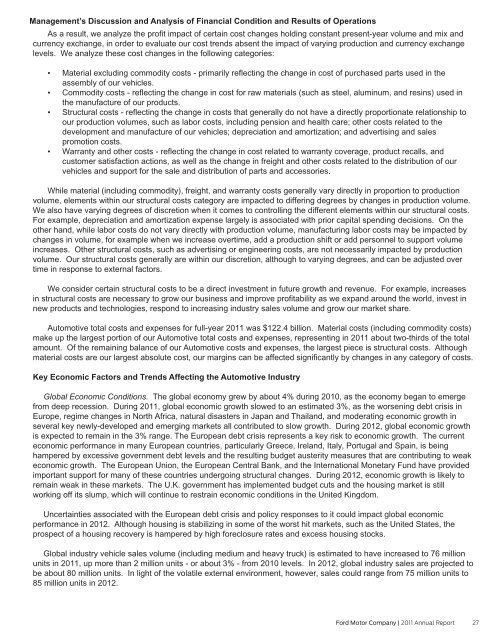PROFITABLE GROWTH FOR ALL
You also want an ePaper? Increase the reach of your titles
YUMPU automatically turns print PDFs into web optimized ePapers that Google loves.
Management’s Discussion and Analysis of Financial Condition and Results of Operations<br />
As a result, we analyze the profit impact of certain cost changes holding constant present-year volume and mix and<br />
currency exchange, in order to evaluate our cost trends absent the impact of varying production and currency exchange<br />
levels. We analyze these cost changes in the following categories:<br />
• Material excluding commodity costs - primarily reflecting the change in cost of purchased parts used in the<br />
assembly of our vehicles.<br />
• Commodity costs - reflecting the change in cost for raw materials (such as steel, aluminum, and resins) used in<br />
the manufacture of our products.<br />
• Structural costs - reflecting the change in costs that generally do not have a directly proportionate relationship to<br />
our production volumes, such as labor costs, including pension and health care; other costs related to the<br />
development and manufacture of our vehicles; depreciation and amortization; and advertising and sales<br />
promotion costs.<br />
• Warranty and other costs - reflecting the change in cost related to warranty coverage, product recalls, and<br />
customer satisfaction actions, as well as the change in freight and other costs related to the distribution of our<br />
vehicles and support for the sale and distribution of parts and accessories.<br />
While material (including commodity), freight, and warranty costs generally vary directly in proportion to production<br />
volume, elements within our structural costs category are impacted to differing degrees by changes in production volume.<br />
We also have varying degrees of discretion when it comes to controlling the different elements within our structural costs.<br />
For example, depreciation and amortization expense largely is associated with prior capital spending decisions. On the<br />
other hand, while labor costs do not vary directly with production volume, manufacturing labor costs may be impacted by<br />
changes in volume, for example when we increase overtime, add a production shift or add personnel to support volume<br />
increases. Other structural costs, such as advertising or engineering costs, are not necessarily impacted by production<br />
volume. Our structural costs generally are within our discretion, although to varying degrees, and can be adjusted over<br />
time in response to external factors.<br />
We consider certain structural costs to be a direct investment in future growth and revenue. For example, increases<br />
in structural costs are necessary to grow our business and improve profitability as we expand around the world, invest in<br />
new products and technologies, respond to increasing industry sales volume and grow our market share.<br />
Automotive total costs and expenses for full-year 2011 was $122.4 billion. Material costs (including commodity costs)<br />
make up the largest portion of our Automotive total costs and expenses, representing in 2011 about two-thirds of the total<br />
amount. Of the remaining balance of our Automotive costs and expenses, the largest piece is structural costs. Although<br />
material costs are our largest absolute cost, our margins can be affected significantly by changes in any category of costs.<br />
Key Economic Factors and Trends Affecting the Automotive Industry<br />
Global Economic Conditions. The global economy grew by about 4% during 2010, as the economy began to emerge<br />
from deep recession. During 2011, global economic growth slowed to an estimated 3%, as the worsening debt crisis in<br />
Europe, regime changes in North Africa, natural disasters in Japan and Thailand, and moderating economic growth in<br />
several key newly-developed and emerging markets all contributed to slow growth. During 2012, global economic growth<br />
is expected to remain in the 3% range. The European debt crisis represents a key risk to economic growth. The current<br />
economic performance in many European countries, particularly Greece, Ireland, Italy, Portugal and Spain, is being<br />
hampered by excessive government debt levels and the resulting budget austerity measures that are contributing to weak<br />
economic growth. The European Union, the European Central Bank, and the International Monetary Fund have provided<br />
important support for many of these countries undergoing structural changes. During 2012, economic growth is likely to<br />
remain weak in these markets. The U.K. government has implemented budget cuts and the housing market is still<br />
working off its slump, which will continue to restrain economic conditions in the United Kingdom.<br />
Uncertainties associated with the European debt crisis and policy responses to it could impact global economic<br />
performance in 2012. Although housing is stabilizing in some of the worst hit markets, such as the United States, the<br />
prospect of a housing recovery is hampered by high foreclosure rates and excess housing stocks.<br />
Global industry vehicle sales volume (including medium and heavy truck) is estimated to have increased to 76 million<br />
units in 2011, up more than 2 million units - or about 3% - from 2010 levels. In 2012, global industry sales are projected to<br />
be about 80 million units. In light of the volatile external environment, however, sales could range from 75 million units to<br />
85 million units in 2012.<br />
Ford Motor Company | 2011 Annual Report 27


